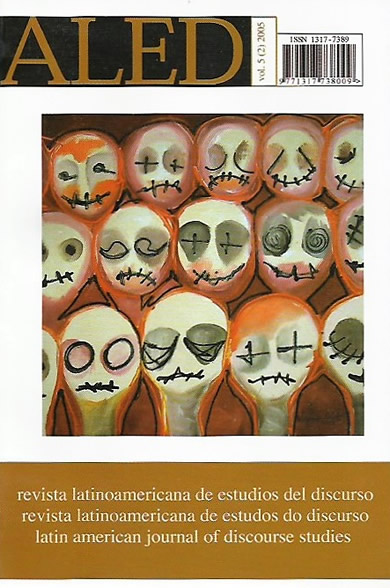La ironía y el humor en El Habla de Monterrey
DOI:
https://doi.org/10.35956/v.5.n2.2005.p.33-47Keywords:
irony. humour. mockery. parody. interview discourse.Abstract
This paper focuses on fragments of interviews from a sociolinguistic corpus which represents the whole universe of analysis. We concentrate our attention on five fragments with the purpose of examining the links between irony and its most frequent companion: humour, and its manifestations as expressed in the discourse of the interviews: laughter, mockery, self-mockery. Humour, in the presence of irony, expresses itself through various textual genres in the interviews. Here we concentrate only on parody. In order to explain the problem, we turn to Kristeva’s proposal on intertextuality; to Bergsons´view of laughter and comicality; and to Freuds´analysis of laughter, comicality and humour in relation with the subconscious. From Jorge Padilla we take the ideas of relax, humour and irony, and from T. Bubnova the concepts of laughter and popular culture. The subjects use humour expressed in laughter, mockery and self-mockery when they use ironize against others and themselves because these offer them the opportunity to perfom a profanation, to disacralize social hierarchies and discourse tones. They offer them a view of an upside down world that looks for equity, although ephemeral and ideal.
Downloads
References
AVERINTSEV, S. (2000) ‘Bajtin, la risa y la cultura cristiana’, en T. Bubnova(ed) En torno a la cultura popular de la risa: Nuevos fragmentos de M. M.Bajtín(Adiciones y cambios a Rabelais), pp. 13-34. Barcelona-México: Rubí-Anthropos/Fund. Cultural Eduardo Cohen, .
BALLART, P. (1994) Eironeia. La figuración retórica en el discurso literario moderno.Barcelona: Quaderns Crema.BERGSON, H. (1986) La risa. Madrid: Orbis.
BERISTÁIN, H. (1997) Diccionario de Retórica y Poética. México: Porrúa.BUBNOVA, T. (ed.) (2000) En torno a la cultura popular de la risa: Nuevos fragmentos de M. M. Bajtin (Adiciones y cambios a Rabelais). Barcelona-México: Rubí- Anthropos/Fund. Cultural Eduardo Cohen.
BERRUTO, G. (1988) La semántica. México: Editorial Patria.
DUCROT, O. (1986) El decir y lo dicho. Polifonía de la enunciación. Barcelona:Paidós.
FREUD, S. (2000) El chiste y su relación con lo inconsciente. Madrid: Alianza.KRISTEVA, J. (1970) El texto de la novela. Barcelona: Lumen.
LOTMAN, I. (1998) La semiosfera, vol. I, Madrid, Cátedra.
PORTILLA, J. (1984) Fenomenología del relajo y otrosensayos. México: Fondode Cultura Económica.
RUTELLI, R. (1997) ‘El texto dentro del texto y la ‘explosión’: ironía, parodia yotros casos’,en M. Cáceres (ed) En la esfera semiótica Lotmaniana. Estudios enhonor a Iuri Mijailóvich Lotman, pp. 401-415.Valencia: Episteme.
ZAVALA, L. (1996) ‘Glosario de términos de ironía narrativa’, Sincronía Revistaelectrónica de la U de G. [Documento en Línea]. Disponible en: http://fuentes.csh.udg.mx/CUCSH/ sincronia/zavalo.html (01/04). Consultadoen enero de 2004.
Downloads
Published
How to Cite
Issue
Section
License

This work is licensed under a Creative Commons Attribution-NonCommercial-NoDerivatives 4.0 International License.
The authors retain the copyright and guarantee RALED the right to be the first publication of the work as well as a Creative Commons Attribution License that allows others to share the work with recognition of authorship and the initial publication in this journal.




